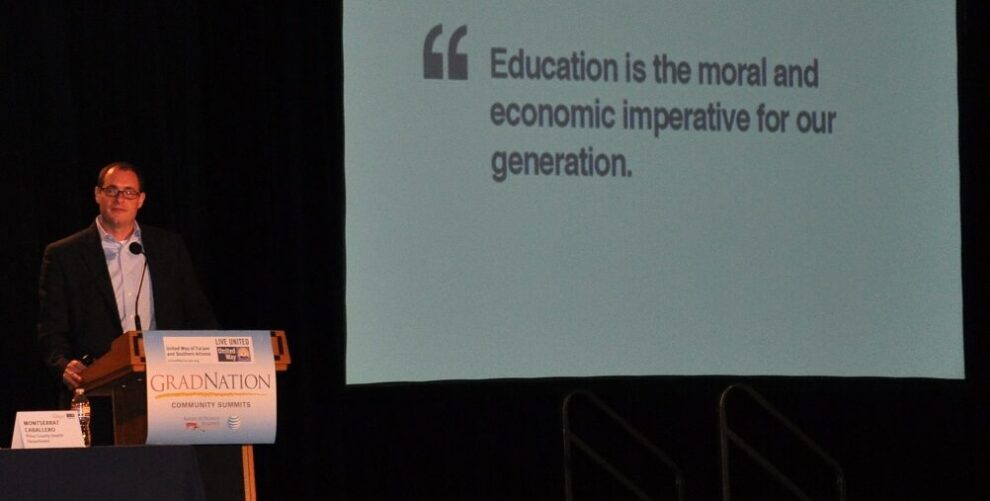Kayia dropped out of high school when her mother was disabled in a car accident, Yanira left after failing most classes her sophomore year, and Francisco quit to support his son.
But a few years later, all three Tucson teens are working toward their high school diplomas.
“I didn’t see education being valuable then,” said Kayia, who now attends Pantano High School in Tucson. “What I thought was valuable at that time was money. I thought money was more valuable than what I should be doing.”

Greg Landsman with Strive Partnership talks about how to transform education during the Grad Nation Summit Dec. 6 in Tucson.
They aren’t alone.
“Right now, more than 30 percent of Tucson youth are not graduating on time from high school,” said Amanda Kucich, director of youth development for United Way of Tucson and Southern Arizona. “Translating that into a real number, 4,400 youth in 2010 alone dropped out of high school in the Tucson metro area.”
Statewide, 76.65 percent of Arizona students graduated on time from high school in 2012, according to the Arizona Department of Education’s four-year graduation rate data. Recently, Pima County business leaders, community organizations, and educators met in Tucson for a Grad Nation Summit to discuss ways to increase their graduation rate to 90 percent in the next six years. In early 2014, those leaders will develop a multi-year plan and a process to evaluate progress with help from a facilitator.
“Why is it important? Because like the great investor Warren Buffett put it, ?It’s because every life has value,’” said Tony Penn, CEO of United Way of Tucson and Southern Arizona. “It’s because the next Steve Jobs, the next Bill Gates may be in one of our classrooms today. That innovation is in the head and heart of that student. It’s up to us to nurture it out.”
The summit in Tucson was organized by United Way of Tucson and Southern Arizona and America’s Promise Alliance which has partnered with AT&T to conduct 100 Grad Nation summits across the nation over the next four years to raise the national graduation rate from today’s 78.2 percent to 90 percent by 2020, with no high school graduating less than 80 percent of its students.
“The economic and overall well-being of Pima County is at risk unless we come together to support our children and youth better,” Penn said.
Paul Luna of Helios Education Foundation, far left, Dr. Lou Albert of Pima Community College’s west campus, left, and Diego Martinez-Barrera a senior at Amphitheater High School, listen to Hon’ Mana Seukteoma, a senior at Baboquivari High School, talk during a panel at the Grad Nation Summit on Dec. 6 in Tucson.

The dropout rate impacts the local economy, because businesses that cannot hire enough skilled local employees may consider relocating to an area with a higher graduation rate and better-qualified applicants, said Joe Snell, executive director of Tucson Regional Economic Opportunities, the lead economic development agency for the greater Tucson area and its surrounding regional partners.
“The labor force is driving all major decisions,” Snell said. “Education is part of that labor pipeline.”
Pima County Juvenile Court strives for good educational outcomes for the 450 kids on probation and 4,400 in out-of-home care and has two educational consultants to help, said Presiding Judge Karen Adam.
“When they come to us they’ve already had failures in school,” Adam said. “The data nationally on educational outcomes for children who have been in the child welfare system is abysmal. Less than half graduate from high school, less than 2 percent achieve higher education and we are responsible for those children and their education.”
Research shows that children with access to caring adults, safe places, a healthy start, effective education and opportunities to help others, are more likely to succeed, so Pima County Grad Nation Summit will determine how to align programs around these “five promises” and examine data to identify what’s working and what challenges remain.
Grad Nation Summit participants discuss ideas during a breakout session on infusing a youth voice to end the dropout crisis during the Dec. 6 event at Pima Community College’s west campus in Tucson.

To create an education system that meets future needs, more emphasis should be placed on the first five years of a child’s life when 90 percent of brain development occurs, classroom learning should leverage technology and focus on collaboration and projects, teacher development should be research-based, and a civic infrastructure should be built that invests in education, makes evidence-based decisions, is collaborative and sustainable, said Greg Landsman, executive director of Strive Partnership.
In the past five years, Strive Together has helped Cincinnati and Northern Kentucky communities make gains in 40 of 53 educational outcomes, including a 9 percent increase in kindergarten readiness, an 11 percent increase in high school graduation, and a 10 percent increase in college enrollment.
“It comes down to rigor and relevance,” said Paul Luna, Helios Education Foundation president and CEO. “When we’re talking about effective education, the student has to understand how what they’re learning in the classroom is going to translate into what they want to do, how they can contribute to society, how it can lead to a meaningful career, and continued lifelong learning and success.”
When this happens, students see a brighter future with college as an option, said Hon’ Mana Seukteoma, a senior at Baboquivari High School in Sells.
When Seukteoma returned to high school she was concerned about the “poisonous environment,” she remembered there years ago. Instead, Seukteoma found a school transformed with a new principal and superintendent, a caring staff, an Advancement Via Individual Determination college readiness program, and dual-enrollment community college classes.
“These changes are huge,” Seukteoma said. “We come from the reservation. We deal with stereotypes that we’ll never leave the reservation. We’ll stay at home and work at the gas station. When all these changes took place, we saw college as an option.”
Seukteoma noted that in 2012, only one person from her high school was accepted to college, but 24 were in 2013.












Add Comment